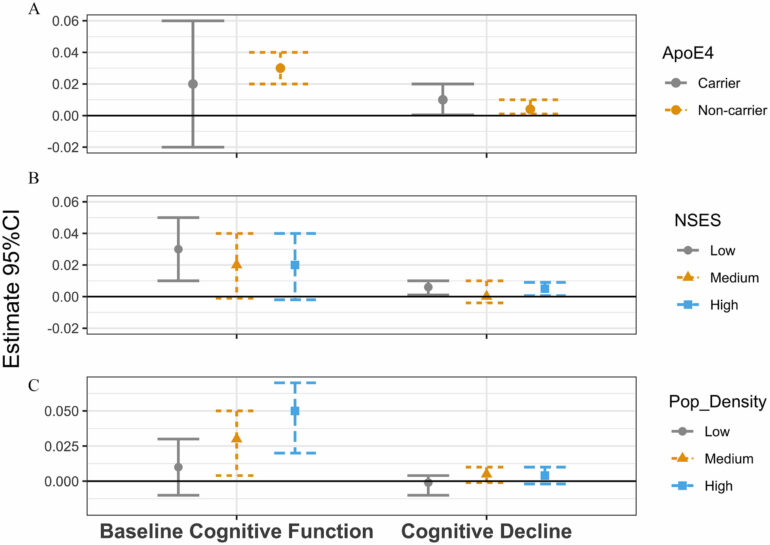Research has shown that about 40% of dementia could be prevented or delayed worldwide by addressing modifiable risk factors associated with the condition, particularly during midlife.
A new study led by a Boston University School of Public Health (BUSPH) researcher is shedding deeper insight on how one risk factor—living near greenery, such as parks and trees—during middle-age years could provide cognitive benefits later in life.
Published in the journal Environmental Health Perspectives, the study found that residing in areas with higher amounts of greenness during midlife may slow a person’s annual rate of cognitive decline by about eight months. This association was stronger among people living in neighborhoods of low socioeconomic status (SES), highly populated neighborhoods.
This association was also observed among people with the APOE-ɛ4 gene, a variant of the APOE gene that is a major risk factor for Alzheimer’s disease. APOE-ɛ4 carriers exposed to more greenery had a threefold magnitude of slower cognitive decline, compared to people without the gene, which is an important research development, as there are currently no known ways for carriers of this gene to reduce their risk of developing dementia.
Greenness exposure has previously been linked to better cognitive functioning, but this new study includes a much larger study group and longer period of observation than prior analyses. It is also the first study to explore how different environmental features may affect the relationship between greenness and cognition among carriers of the APOE-ɛ4 gene.
Considering that Alzheimer’s disease and related dementia cases may develop as many as 20 years before recognizable symptoms appear, it is critical to identify which populations are most susceptible to these conditions and the protective measures that can be implemented as early as possible in life to thwart or slow cognitive impairment.
“Our results are important because they shed light into the cognitive benefits of increasing green space exposure at a population level, particularly among vulnerable subgroups of the population, such as carriers of the APOE-ɛ4 gene,” says study lead and corresponding author Dr. Marcia Pescador Jimenez, assistant professor of epidemiology at BUSPH.
To examine the association between residential greenness and cognitive function and decline, Dr. Pescador Jimenez and colleagues from Rush Medical College, Rush Alzheimer’s Disease Center, and Harvard T.H. Chan School of Public Health utilized data from the Nurses’ Health Study (NHS), a prospective study that began in 1976 and is among the largest investigations into the risk factors for chronic diseases among US women.
The team focused on 16,962 nurses aged 70 or older who were enrolled in an NHS substudy that started between 1995–2001 and lasted through 2008. The participants were assessed for cognitive function through telephone surveys, and the researchers utilized a satellite image-based metric to measure greenness levels around participants’ residential areas. They assessed greenness exposure up to nine years prior to the first cognitive test, and the total cognitive assessment included five cognitive tests administered up to four times over an average of six years.
After adjusting for age and socioeconomic factors, higher average exposure to greenness during midlife was linked to higher levels of cognitive function as well as slower cognitive decline, based on global cognition scores but not verbal memory.
Importantly, this association was stronger for participants living in low-SES and highly populated neighborhoods, suggesting that efforts to increase greenery in disadvantaged areas could help reduce socioeconomic inequities among these populations.
“Our finding for participants living in neighborhoods with lower socioeconomic status is consistent with the theory of equigenic environments, which suggests that greenness might be important to reduce socioeconomic health inequities,” Dr. Pescador Jimenez says.
The study also explored the role of mental health in the relationship between midlife greenness exposure and cognition. While previous research has suggested that limited exposure to greenery in middle age can decrease cognitive functioning by way of depression, the new data extends this connection by suggesting that greenness maybe associated with cognitive decline over time through mental health.
“The findings emphasize the importance of prioritizing the preservation and creation of green spaces, particularly in low-SES neighborhoods, as a means of promoting cognitive health later in life,” says Dr. Pescador Jimenez.
More information:
Marcia Pescador Jimenez et al, Midlife Residential Greenness and Late-Life Cognitive Decline among Nurses’ Health Study Participants, Environmental Health Perspectives (2024). DOI: 10.1289/EHP13588
Citation:
Living in greener neighborhoods during midlife can slow cognitive decline (2024, July 17)



